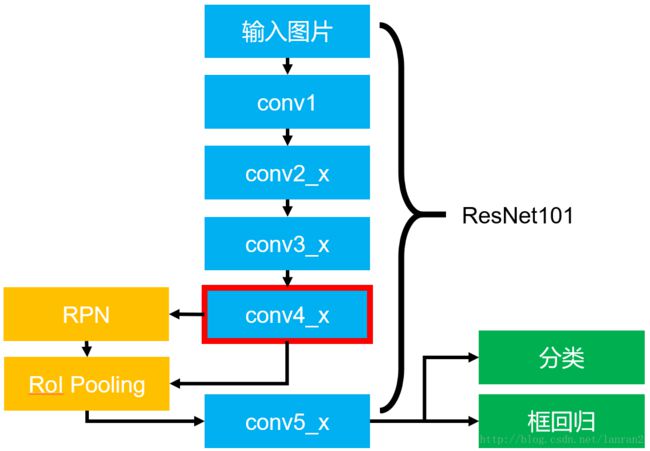maskrcnn_benchmark理解记录——modeling\roi_heads\box_head\roi_box_feature_extractors.py
摘取config记录如下
MODEL:
META_ARCHITECTURE: "GeneralizedRCNN"
WEIGHT: "catalog://ImageNetPretrained/MSRA/R-50"
BACKBONE:
CONV_BODY: "R-50-FPN"
RESNETS:
BACKBONE_OUT_CHANNELS: 256
ROI_HEADS:
USE_FPN: True
ROI_BOX_HEAD:
POOLER_RESOLUTION: 7
POOLER_SCALES: (0.25, 0.125, 0.0625, 0.03125)
POOLER_SAMPLING_RATIO: 2
FEATURE_EXTRACTOR: "FPN2MLPFeatureExtractor"
PREDICTOR: "FPNPredictor"
NUM_CLASSES: 2MODEL.ROI_BOX_HEAD:
POOLER_RESOLUTION: 7
POOLER_SCALES: (0.25, 0.125, 0.0625, 0.03125)
POOLER_SAMPLING_RATIO: 2
FEATURE_EXTRACTOR: "FPN2MLPFeatureExtractor"
1.关于POOLER_SCALES: (0.25, 0.125, 0.0625, 0.03125)和POOLER_SAMPLING_RATIO: 2
_C.MODEL.ROI_BOX_HEAD.POOLER_SCALES = (0.25, 0.125, 0.0625, 0.03125)
_C.MODEL.ROI_BOX_HEAD.POOLER_SAMPLING_RATIO = 2
POOLER_SCALES是由于backbone(Resnet或Resnext架构)的strides生成的不同的缩小比例,(因为后四层作RPN的,所以这里是四层# conv2_x →conv5_x 作为特征提取层 那么对应POOLER_SCALES: (0.25, 0.125, 0.0625, 0.03125) 其实是第2到5层的池化 1/4;1/8;1/16;1/32)。BTW, you should understand well the ResNet and ResNeXt architectures to better understand this explanation.resnet【链接】【链接】a
例如,假设您在输入图像中找到了坐标[0,0,64,64]的RoI。 再次假设您希望从所有backbone的层级pool its features (这个其实还挺好玩,常叫pool为池化,但其实是pool its features,汇集其特征。那其实pool就是一步步地聚集、提取特征)
So, since there is a stride of 2 in the conv1 layer and another stride of 2 at the end of the first block, it results in a feature-map 4x smaller than the original image, thus, a scale of 0.25(这里 是到conv2_x). Since, there is a stride of 2 between all the convolution blocks of the backbone, the scale gets divided by 2 at each level.
Hence, the coordinates of your RoI will be:
[0, 0, 16, 16]in the first level feature-map[0, 0, 8, 8]in the second level feature-map[0, 0, 4, 4]in the third level feature-map[0, 0, 2, 2]in the fourth level feature-map
The sampling_ratio parameter determines how many samples you want to do in the bi-linear interpolation of the RoIAlign algorithm.
也就是这里:
(1)
(2)基于ResNet的Faster RCNN中RPN的共享特征图用的是conv4_x的输出。
以发现conv4_x的最后的输出为RPN和RoI Pooling共享的部分,而conv5_x(共9层网络)都作用于RoI Pooling之后的一堆特征图(14 x 14 x 1024),特征图的大小维度也刚好符合原本的ResNet101中conv5_x的输入;
conv4_x(14*14*1024)→RoI Pooling→(14*14*1024)→conv5_x(7*7*2048)→pooling→1*1*2018→2048 x 1000
(到底是只把RoI Pooling的结果作为conv5_x的输入,还是说RoI Pooling的结果和顺着的ResNet101中conv5_x映射????)
最后要接一个average pooling是针对整个channel×H×W的特征图,把每个H×W Pooling成1个像素,得到channel×1×1维特征(conv5_x输出是2048 x (7 x 7)大小的特征图,pooling操作是取每个7x7的最大或者平均值,最后我们得到的是2048 x (1 x 1)),最后的fc是2048 x 1000;分别用于分类和框回归。
而mask rcnn是:
(RCNN Head):
conv4_x(sizew4*sizeh4*1024)→conv5_x(sizew5*sizeh5*2048)→RoIAlign→7*7*256→1*1*1024→1*1*1024→1024
(Mask Head):
conv4_x(sizew4*sizeh4*1024)→RoIAlign→14*14*256→×4→14*14*256→28*28*256→28*28*C
(Keyponts Head)是:
conv4_x(sizew4*sizeh4*1024)→RoIAlign→14*14*256→14*14*512→×8→14*14*512→7*7*17
3.其实FEATURE_EXTRACTOR: "FPN2MLPFeatureExtractor",是指的用这个特征提取层做分类和回归。是后面的部分,也就是RCNN Head。
# Copyright (c) Facebook, Inc. and its affiliates. All Rights Reserved.
import torch
from torch import nn
from torch.nn import functional as F
from maskrcnn_benchmark.modeling import registry
from maskrcnn_benchmark.modeling.backbone import resnet
from maskrcnn_benchmark.modeling.poolers import Pooler
from maskrcnn_benchmark.modeling.make_layers import group_norm
from maskrcnn_benchmark.modeling.make_layers import make_fc
@registry.ROI_BOX_FEATURE_EXTRACTORS.register("ResNet50Conv5ROIFeatureExtractor")
class ResNet50Conv5ROIFeatureExtractor(nn.Module):
def __init__(self, config, in_channels):
super(ResNet50Conv5ROIFeatureExtractor, self).__init__()
resolution = config.MODEL.ROI_BOX_HEAD.POOLER_RESOLUTION
scales = config.MODEL.ROI_BOX_HEAD.POOLER_SCALES
sampling_ratio = config.MODEL.ROI_BOX_HEAD.POOLER_SAMPLING_RATIO
pooler = Pooler(
output_size=(resolution, resolution),
scales=scales,
sampling_ratio=sampling_ratio,
)
stage = resnet.StageSpec(index=4, block_count=3, return_features=False)
head = resnet.ResNetHead(
block_module=config.MODEL.RESNETS.TRANS_FUNC,
stages=(stage,),
num_groups=config.MODEL.RESNETS.NUM_GROUPS,
width_per_group=config.MODEL.RESNETS.WIDTH_PER_GROUP,
stride_in_1x1=config.MODEL.RESNETS.STRIDE_IN_1X1,
stride_init=None,
res2_out_channels=config.MODEL.RESNETS.RES2_OUT_CHANNELS,
dilation=config.MODEL.RESNETS.RES5_DILATION
)
self.pooler = pooler
self.head = head
self.out_channels = head.out_channels
def forward(self, x, proposals):
x = self.pooler(x, proposals)
x = self.head(x)
return x
#RCNN head的那部分 class +box
@registry.ROI_BOX_FEATURE_EXTRACTORS.register("FPN2MLPFeatureExtractor")
class FPN2MLPFeatureExtractor(nn.Module):
"""
Heads for FPN for classification
"""
def __init__(self, cfg, in_channels):
super(FPN2MLPFeatureExtractor, self).__init__()
resolution = cfg.MODEL.ROI_BOX_HEAD.POOLER_RESOLUTION #14→7
scales = cfg.MODEL.ROI_BOX_HEAD.POOLER_SCALES #(0.25, 0.125, 0.0625, 0.03125)
sampling_ratio = cfg.MODEL.ROI_BOX_HEAD.POOLER_SAMPLING_RATIO #2
pooler = Pooler(
output_size=(resolution, resolution),
scales=scales,
sampling_ratio=sampling_ratio,
)
input_size = in_channels * resolution ** 2 # 256*7**7 RCNN head的那部分
#Hidden layer dimension when using an MLP for the RoI box head
representation_size = cfg.MODEL.ROI_BOX_HEAD.MLP_HEAD_DIM #1024
use_gn = cfg.MODEL.ROI_BOX_HEAD.USE_GN #False
self.pooler = pooler
self.fc6 = make_fc(input_size, representation_size, use_gn)
self.fc7 = make_fc(representation_size, representation_size, use_gn)
self.out_channels = representation_size #1024
def forward(self, x, proposals):
x = self.pooler(x, proposals)
x = x.view(x.size(0), -1)
x = F.relu(self.fc6(x))
x = F.relu(self.fc7(x))
return x
@registry.ROI_BOX_FEATURE_EXTRACTORS.register("FPNXconv1fcFeatureExtractor")
class FPNXconv1fcFeatureExtractor(nn.Module):
"""
Heads for FPN for classification
"""
def __init__(self, cfg, in_channels):
super(FPNXconv1fcFeatureExtractor, self).__init__()
resolution = cfg.MODEL.ROI_BOX_HEAD.POOLER_RESOLUTION
scales = cfg.MODEL.ROI_BOX_HEAD.POOLER_SCALES
sampling_ratio = cfg.MODEL.ROI_BOX_HEAD.POOLER_SAMPLING_RATIO
pooler = Pooler(
output_size=(resolution, resolution),
scales=scales,
sampling_ratio=sampling_ratio,
)
self.pooler = pooler
use_gn = cfg.MODEL.ROI_BOX_HEAD.USE_GN
conv_head_dim = cfg.MODEL.ROI_BOX_HEAD.CONV_HEAD_DIM
num_stacked_convs = cfg.MODEL.ROI_BOX_HEAD.NUM_STACKED_CONVS
dilation = cfg.MODEL.ROI_BOX_HEAD.DILATION
xconvs = []
for ix in range(num_stacked_convs):
xconvs.append(
nn.Conv2d(
in_channels,
conv_head_dim,
kernel_size=3,
stride=1,
padding=dilation,
dilation=dilation,
bias=False if use_gn else True
)
)
in_channels = conv_head_dim
if use_gn:
xconvs.append(group_norm(in_channels))
xconvs.append(nn.ReLU(inplace=True))
self.add_module("xconvs", nn.Sequential(*xconvs))
for modules in [self.xconvs,]:
for l in modules.modules():
if isinstance(l, nn.Conv2d):
torch.nn.init.normal_(l.weight, std=0.01)
if not use_gn:
torch.nn.init.constant_(l.bias, 0)
input_size = conv_head_dim * resolution ** 2
representation_size = cfg.MODEL.ROI_BOX_HEAD.MLP_HEAD_DIM
self.fc6 = make_fc(input_size, representation_size, use_gn=False)
self.out_channels = representation_size
def forward(self, x, proposals):
x = self.pooler(x, proposals)
x = self.xconvs(x)
x = x.view(x.size(0), -1)
x = F.relu(self.fc6(x))
return x
def make_roi_box_feature_extractor(cfg, in_channels):
func = registry.ROI_BOX_FEATURE_EXTRACTORS[
cfg.MODEL.ROI_BOX_HEAD.FEATURE_EXTRACTOR
] #@registry.ROI_BOX_FEATURE_EXTRACTORS.register("FPN2MLPFeatureExtractor")
return func(cfg, in_channels) #return x



